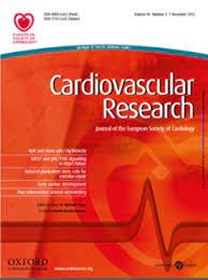心肌细胞中钙调素基因的不同时空表达是钙调素依赖信号功能多样性的基础
IF 10.2
1区 医学
Q1 CARDIAC & CARDIOVASCULAR SYSTEMS
引用次数: 0
摘要
本研究旨在通过研究Calmodulin (Calmodulin, CaM)的三个基因calm1、Calm2和calm3在心肌细胞中是否发挥着独特或冗余的作用,重点研究它们的空间mRNA定位和与关键靶点的相互作用,来解决CaM信号多样性的机制。方法与结果利用单分子mRNA检测和三维成像技术绘制了心肌细胞内Calm1、Calm2和Calm3 mRNA的空间分布。这些mrna被发现一致地定位在特定的细胞区域内,与它们的靶mrna重叠并形成区域特异性转录物连接。这种空间组织与两种不同的蛋白质合成途径一致:Cx43等蛋白质在细胞核附近集中合成,RyR2等蛋白质在更外围的细胞质区域局部合成。消融Calm1触发Calm2和Calm3代偿性增加;然而,这种补偿不足以恢复正常的CaM转录本分布,导致ca2 +的处理中断。在肥厚性心力衰竭(HF)的情况下,CaM转录本的分布和空间相互作用,虽然可能适应支持心肌细胞生长,但被破坏,导致CaM信号紊乱。我们的研究结果表明,Calm1、Calm2和Calm3通过其空间调控的mRNA定位(时空编码)在心肌细胞中发挥着不同的、非冗余的作用。这种对mRNA定位的精确空间控制对区域特异性CaM信号传导至关重要,在肥厚性心力衰竭中被破坏,导致病理性重构。本文章由计算机程序翻译,如有差异,请以英文原文为准。
Distinct intracellular spatiotemporal expression of Calmodulin genes underlies functional diversity of CaM-dependent signaling in cardiac myocytes
Aims This study aims to resolve the mechanisms underlying Calmodulin (CaM)'s signaling diversity by investigating whether the three CaM genes—Calm1, Calm2, and Calm3—play distinct or redundant roles in cardiac myocytes, focusing on their spatial mRNA localization and interactions with key targets. Methods and Results We utilized single-molecule mRNA detection and 3D imaging to map the spatial distribution of Calm1, Calm2, and Calm3 mRNAs within ventricular myocytes. These mRNAs were found to be consistently positioned within specific cellular zones, overlapping with their target mRNAs and forming region-specific transcript conjunctions. This spatial organization aligns with two distinct protein synthesis pathways: centralized synthesis near the nucleus for proteins such as Cx43 and localized synthesis in more peripheral cytosolic areas for proteins like RyR2. Ablation of Calm1 triggered compensatory increases in Calm2 and Calm3; however, this compensation was insufficient to restore normal CaM transcript distribution, leading to disrupted Ca²⁺ handling. In the context of hypertrophic heart failure (HF), the distribution and spatial interactions of CaM transcripts, while potentially adaptive to support myocyte growth, become disrupted, leading to disorganized CaM signaling. Conclusion Our findings reveal that Calm1, Calm2, and Calm3 fulfill distinct, non-redundant roles in cardiac myocytes through their spatially regulated mRNA localization (spatiotemporal coding). This precise spatial control of mRNA localization is critical for region-specific CaM signaling and is disrupted in hypertrophic heart failure, contributing to pathological remodeling.
求助全文
通过发布文献求助,成功后即可免费获取论文全文。
去求助
来源期刊

Cardiovascular Research
医学-心血管系统
CiteScore
21.50
自引率
3.70%
发文量
547
审稿时长
1 months
期刊介绍:
Cardiovascular Research
Journal Overview:
International journal of the European Society of Cardiology
Focuses on basic and translational research in cardiology and cardiovascular biology
Aims to enhance insight into cardiovascular disease mechanisms and innovation prospects
Submission Criteria:
Welcomes papers covering molecular, sub-cellular, cellular, organ, and organism levels
Accepts clinical proof-of-concept and translational studies
Manuscripts expected to provide significant contribution to cardiovascular biology and diseases
 求助内容:
求助内容: 应助结果提醒方式:
应助结果提醒方式:


